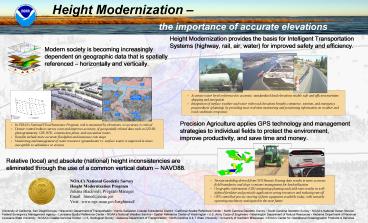Height Modernization - PowerPoint PPT Presentation
Title:
Height Modernization
Description:
Height Modernization the importance of accurate elevations Accurate water levels referenced to accurate, standardized land elevations enable safe and efficient ... – PowerPoint PPT presentation
Number of Views:100
Avg rating:3.0/5.0
Title: Height Modernization
1
Height Modernization the
importance of accurate elevations
Height Modernization provides the basis for
Intelligent Transportation Systems (highway,
rail, air, water) for improved safety and
efficiency.
Modern society is becoming increasingly dependent
on geographic data that is spatially referenced
horizontally and vertically.
Precision Agriculture applies GPS technology and
management strategies to individual fields to
protect the environment, improve productivity,
and save time and money.
- In FEMAs National Flood Insurance Program, risk
is measured by elevations, so accuracy is
critical - Denser control reduces survey costs and improves
accuracy of geospatially related data such as
LIDAR, photogrammetry, GIS, RTK, construction
plans, and evacuation routes - Benefits include more accurate floodplain and
insurance rate maps - Monitoring and management of water resources
(groundwater vs. surface water) is improved in
areas susceptible to subsidence or erosion
Relative (local) and absolute (national) height
inconsistencies are eliminated through the use of
a common vertical datum -- NAVD88.
NOAAs National Geodetic Survey Height
Modernization Program Juliana Blackwell, Program
Manager Email htmod_at_noaa.gov Visit
www.ngs.noaa.gov/heightmod/
University of California, San Diego/Scripps
Wisconsin Department of Transportation
Harris-Galveston Coastal Subsidence District
California Spatial Reference Center North
Carolina Geodetic Survey South Carolina
Geodetic Survey NOAAs National Ocean Service
Federal Emergency Management Agency Louisiana
Spatial Reference Center NOAAs National
Weather Service Spatial Reference Center of
Washington U.S. Army Corps of Engineers
Washington Department of Natural Resources
Alabama Department of Revenue Louisiana State
University NOAAs Coastal Services Center
U.S. Geological Survey Alabama Department of
Transportation North Carolina A T State
University University of Southern Mississippi
NOAAs Center for Operational Oceanographic
Products Services































